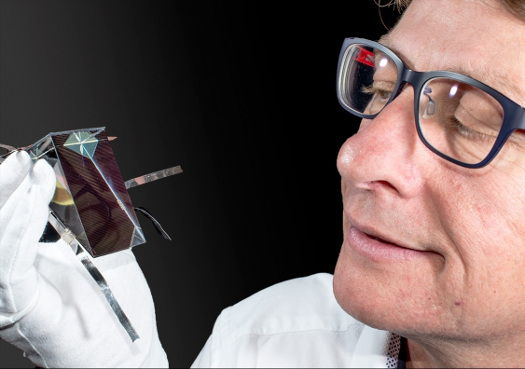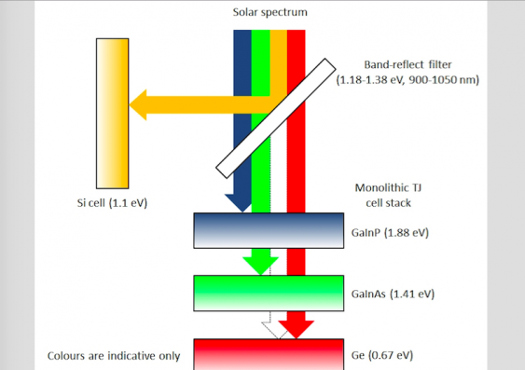 |
| May 24, 2016 | Volume 12 Issue 20 |
Designfax weekly eMagazine
Archives
Partners
Manufacturing Center
Product Spotlight
Modern Applications News
Metalworking Ideas For
Today's Job Shops
Tooling and Production
Strategies for large
metalworking plants
The prism did it: New world record set in solar cell efficiency

Dr. Mark Keevers with one of the spectrum splitting, four-junction mini-modules developed at UNSW.
A new solar cell configuration developed by engineers at the University of New South Wales (UNSW) in Australia has pushed sunlight-to-electricity conversion efficiency to 34.5 percent -- establishing a new world record for unfocused sunlight and nudging closer to the theoretical limits for such a device.
The record was set by Dr. Mark Keevers and Professor Martin Green, Senior Research Fellow and Director, respectively, of UNSW's Australian Centre for Advanced Photovoltaics, using a 28-cm2 four-junction mini-module -- embedded in a prism -- that extracts the maximum energy from sunlight. It does this by splitting the incoming rays into four bands, using a hybrid four-junction receiver to squeeze even more electricity from each beam of sunlight.
The new UNSW result, confirmed by the U.S. National Renewable Energy Laboratory, is almost 44 percent better than the previous record (made by Alta Devices of the United States, which reached 24 percent efficiency, but over a larger surface area of 800-cm2).
"This encouraging result shows that there are still advances to come in photovoltaics research to make solar cells even more efficient," said Keevers. "Extracting more energy from every beam of sunlight is critical to reducing the cost of electricity generated by solar cells, as it lowers the investment needed and delivers payback faster."
The result was obtained by the same UNSW team that set a world record in 2014, achieving an electricity conversion rate of over 40 percent by using mirrors to concentrate the light -- a technique known as CPV (concentrator photovoltaics) -- and then similarly splitting out various wavelengths. The new result, however, was achieved using normal sunlight with no concentrators.
"What's remarkable is that this level of efficiency had not been expected for many years," said Green, a pioneer who has led the field for much of his 40 years at UNSW. "A recent study by Germany's Agora Energiewende think tank set an aggressive target of 35 percent efficiency by 2050 for a module that uses unconcentrated sunlight, such as the standard ones on family homes.
"So things are moving faster in solar cell efficiency than many experts expected, and that's good news for solar energy," he added.
The record-setting UNSW mini-module combines a silicon cell on one face of a glass prism, with a triple-junction solar cell on the other.
The triple-junction cell targets discrete bands of the incoming sunlight, using a combination of three layers: indium-gallium-phosphide, indium-gallium-arsenide, and germanium. As sunlight passes through each layer, energy is extracted by each junction at its most efficient wavelength, while the unused part of the light passes through to the next layer, and so on.
Some of the infrared band of incoming sunlight, unused by the triple-junction cell, is filtered out and bounced onto the silicon cell, thereby extracting just about all of the energy from each beam of sunlight hitting the mini-module.

A diagram of the spectrum-splitting, four-junction mini-module developed at UNSW.
The 34.5 percent result with the 28 cm2 mini-module is already a world record, but scaling it up to a larger 800-cm2 unit -- thereby leaping beyond Alta Devices' 24 percent -- is well within reach. "There'll be some marginal loss from interconnection in the scale-up, but we are so far ahead that it's entirely feasible," Keevers said. The theoretical limit for such a four-junction device is thought to be 53 percent, which puts the UNSW result two-thirds of the way there.
One downside: Multi-junction solar cells of this type are unlikely to find their way onto the rooftops of homes and offices soon, as they require more effort to manufacture and therefore cost more than standard crystalline silicon cells with a single junction. But the UNSW team is working on new techniques to reduce the manufacturing complexity and create cheaper multi-junction cells.
However, the spectrum-splitting approach is perfect for solar towers, like those being developed by Australia's RayGen Resources, which use mirrors to concentrate sunlight that is then converted directly into electricity.
The research is supported by a $1.4 million grant from the Australian Renewable Energy Agency (ARENA), whose CEO, Ivor Frischknecht, said the achievement demonstrated the importance of supporting early-stage renewable energy technologies.
Other research partners working with UNSW include Trina Solar, a PV module manufacturer, and the U.S. National Renewable Energy Laboratory.
Source: UNSW
Published May 2016
Rate this article
View our terms of use and privacy policy
